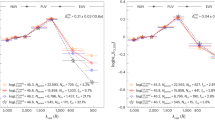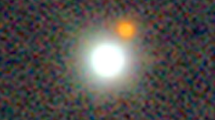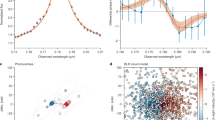Abstract
Several quasars show an excess of radiation in the ultraviolet over the power law defined by their infrared/optical continuum. Several authors1–4 have fitted the infrared to ultraviolet spectrum of these quasars with a combination of a power law component, line emission, blends of Fe II lines, Balmer continuum and a black-body component which dominates the ultraviolet spectrum. We report here the first observations of variability in the ultraviolet spectrum of the quasar 3C273 (redshift, z = 0.158) as observed by the International Ultraviolet Explorer (IUE)5 in the period 1978–84. The flux at λobserved = 1,675 Å increased by 1.25 between April and June 1982, then decreased by a factor 2 between June 1982 and April 1983. The amplitude of these variations and the constancy of the intensity of the Lyα emission line during the same period are indications that the ultraviolet variations are caused by variations of the black body and/or non-thermal components and not by variations of the continuum or blend of lines originating from the broad-line region. The flux variations are accompanied by variations of the spectral shape. We present an interpretation of the observed variability in terms of a discontinuous and variable distribution of the temperature on the photosphere emitting the ultraviolet continuum.
This is a preview of subscription content, access via your institution
Access options
Subscribe to this journal
Receive 51 print issues and online access
$199.00 per year
only $3.90 per issue
Buy this article
- Purchase on Springer Link
- Instant access to full article PDF
Prices may be subject to local taxes which are calculated during checkout
Similar content being viewed by others
References
Shields, G. A. Nature 272, 706–708 (1978).
Ulrich, M. H. Space Sci. Rev. 28, 89–104 (1981).
Malkan, M. A. Astrophys. J. 268, 582–590 (1983).
Camenzind, M. & Courvoisier, T. J.-L. Astr. Astrophys. 140, 341–344 (1984).
Boggess, A. et al. Nature 275, 372–376 (1978).
Wills, B. J., Netzer, H. & Wills, D. Astrophys. J. 288, 94–116 (1985).
Wu, C.-C. Astrophys. J. Lett. 217, L117–120 (1977).
Sonneborn, G. & Garhart, M. P. NASA IUE Newslett. 23, 23–30 (1983).
Oliversen, N. A. NASA WE Newslett. 23, 31–43 (1983).
Perola, G. C. et al. Mon. Not. R. astr. Soc. 200, 293–312 (1982).
Camenzind, M. & Courvoisier, T. J.-L. Astrophys. J. Lett. 66, L83–87 (1983).
Robson, E. I. et al. Nature 305, 194–196 (1983).
Kwan, J. Astrophys. J. 283, 70–80 (1984).
Author information
Authors and Affiliations
Rights and permissions
About this article
Cite this article
Courvoisier, TL., Ulrich, M. Ultraviolet continuum variability of the quasar 3C273. Nature 316, 524–526 (1985). https://doi.org/10.1038/316524a0
Received:
Accepted:
Published:
Issue Date:
DOI: https://doi.org/10.1038/316524a0
Comments
By submitting a comment you agree to abide by our Terms and Community Guidelines. If you find something abusive or that does not comply with our terms or guidelines please flag it as inappropriate.



